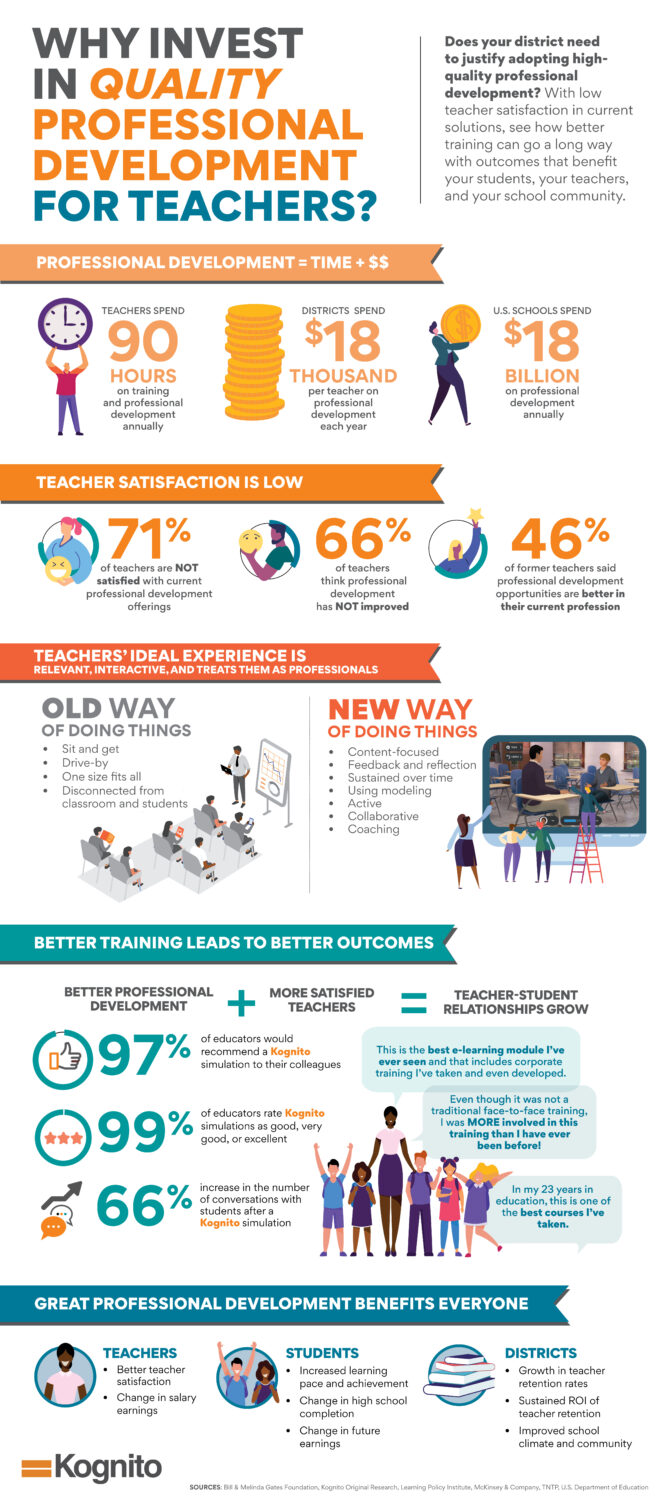Infographic: Evaluating Professional Development for K-12 Teachers and Staff
Districts invest a lot of time and resources in professional development (PD) for educators. Every year, U.S. schools spend $18 billion on PD for teachers every year, which consume about 10% of teachers’ time.
Unfortunately, 71% of teachers are not satisfied with current PD offerings. Some of the common reasons school staff dislike professional development include its time-consumption and boring, inapplicable, and outdated content.
These red-flag statistics and results from numerous studies have led to districts across the country carefully evaluating professional development for K-12 teachers and staff, and determining how to use their PD dollars wisely to have the greatest benefit for both teachers and students.
Why Invest in PD
Before evaluating professional development for K12 districts, it’s important to understand the intended outcomes. PD is about educating the educators … but why? The infographic below summarizes some of the key outcomes of PD, but we’ll explore each outcome more in-depth in this post.

Teacher Retention
PD is important for staff retention because it provides opportunities for growth and can improve employee satisfaction. It also has been shown to increase staff efficacy and feelings of competency, which leads to more motivation and a sense of belonging.
According to a report published by the New Teacher Center (NTC), an effective professional development program increased teacher retention rates year over year. In the study, 78% of teachers who received training were retained the following year, 11 percentage points higher than in the comparison group. Hiring a new teacher can cost upwards of $17,000 per teacher that needs to be replaced. By improving retention rates through effective PD, districts can improve teacher satisfaction and save thousands of dollars in staff replacements costs.
Student Achievement
Several large-scale studies have illustrated how effective PD has the power to improve student achievement. In one study that included 1,500 K-12 schools, successful PD was linked to:
- Reduced dropout rates
- Lower absenteeism rates
- Academic achievement gains in math, science, history, and reading
Students from the NTC report who benefited from teachers who received effective PD demonstrated up to 5 months of additional learning on standardized tests and had the potential to earn an additional $38,000 in their career lifetime, demonstrating both short- and long-term outcomes for students. An increase in income potential leads to more tax dollars—which is also a long-term benefit for the school districts who benefit from these tax dollars.
School Climate
Measurements of climate and culture—including attendance and suspension rates and general climate surveys—are being used nationally to assess school performance.
Some of the key ways districts are working to improve these metrics are through incorporating social-emotional learning (SEL) in the classroom, as well as providing teacher support through PD opportunities. More than half of teachers do not feel supported in their jobs, and 25% consider leaving the profession as a result. Educators make up a large and influential portion of a school’s population. Without adequate PD opportunities, creating a positive learning environment is unlikely.
When evaluating professional development for K-12 grades, it’s important to understand the kind of engaging PD educators want. They report dissatisfaction with “sit and get,” one-size-fits-all PD while favoring personalized and interactive learning. Additionally, giving them a voice in the form of feedback can help foster a sense of collaboration and community.
Improved Relationships
In a typical school year, students spend more than 1,000 hours with their teacher. The impact of that relationship is undeniable, which is why PD that focuses on a teachers’ ability to improve student relationships through the social and emotional components of learning are gaining in popularity.
Research suggests that positive teacher-student relationships help drive student success, and that students need to feel safe and understood in order to improve outcomes.
In one of our mental health and suicide prevention simulation trainings, At Risk for High School Educators, educators who completed the training reported a 71% increase in the average number of students they approached to discuss their concern. They also referred 37% more students to support services—a demonstration of the improved relationship skills gained through PD.
What to Look for When Evaluating Professional Development for K-12
Investing in PD has short- and long-term benefits that impact students, teachers, school climate, and the community at large. But not all PD is created equal. As cited earlier, 71% of teachers are not satisfied with current PD offerings.
When evaluating professional development for K-12 teachers and staff, there are certain criteria to look for in order to increase your chances of achieving the successful results identified in this post, and we’d love to share them with you to help you in your search.
Our free whitepaper, Criteria for Selecting Mental Health Training for K-12 School Personnel, describes key factors that have been proven to help achieve positive outcomes, so you can be confident you’re investing your PD dollars wisely.
If you’re curious about our virtual simulations and how they can provide engaging and effective PD for educators and school staff, we’d love for you to take a demo of one of our PK-12 simulations here.
Explore more articles from the Kognito blog:
